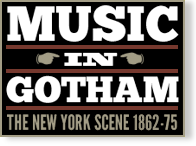Philharmonic Society of New York Public Rehearsal
Event Information
Venue(s):
Academy of Music
Conductor(s):
Carl Bergmann
Event Type:
Orchestral
Record Information
Status:
Published
Last Updated:
16 June 2025
Performance Date(s) and Time(s)
08 Jan 1875, 2:30 PMPerformers and/or Works Performed
Citations
“At the Academy of Music yesterday afternoon, the first rehearsal of the programme for the third concert of the New York Philharmonic Society was held under the direction of Mr. Bergmann. The first piece was Haydn’s Symphony in C minor, which, though new to the society, has been performed more than once at the concerts of the Church Music Association. On these occasions, and yesterday at the Philharmonic, in his place as first violoncellist, Mr. F. Bergner played the solo in the Trio of the Minuet. Bach’s celebrated’Ciaconna,’ in D minor, arranged for orchestra by Raff, which was played at the last concert, was included in the programme by particular request. This great work cannot fail to become more and more interesting as its merits become better known. Joachim Raff’s decision that each beat should occupy the eighty-eighth part of a minuet was not regarded by the conductor, who chose a much slower tempo; and thus there was little difficulty experienced in distinctly articulating all the rapid passages, and making clear all the details. But some parts, especially the chromatic duet for two flutes, beginning about thirty bars from the end, did not gain by this arrangement. Other parts, however, became more dignified and stately, and well suited to this very large orchestra.
Wagner’s introduction to the grand and beautiful tragedy of ‘Tristan und Isolde’ was a great treat to all. It opens with the motive employed in the opera to suggest the idea of the love-potion, which is played with great feeling and tenderness. To this succeeds a very passionate melody, that gains greatly in intensity by being played throughout by the violins on the fourth string. We have already given a characterization of this lovely prelude. It was most carefully rehearsed.
Raff’s symphony in D minor has also been reviewed in full. The movement which seemed to receive most favor was the Larghetto in the style of a funeral march. The Scherzo, though not taken at very high speed, failed to create great interest; and the examples of imitation by augmentation found therein passed unobserved by many, even at this tempo, paratly because the rhythmic design of the subject is not sufficiently varied to attract attention.”
“A very small audience attended the first rehearsal of the third concert of the Philharmonic Society for the present season at the Academy of Music yesterday afternoon. The orchestra of 100 performers were present, with Herr Carl Bergmann as conductor. The programme for the next concert is very interesting and well chosen, consisting of the following works [see above]…the rehearsal closed with a very weak, commonplace symphony by Raff, the sixth of the series in D minor, opus 189. This last work is unworthy of the composer of the ‘Im Walde’ and ‘Lenore’ symphonies. The subjects are so commonplace and uninteresting that no amount of clever instrumentation can recommend them to the attention of the musical public. Raff, we fear, has written himself out, and is now engaged in the machine business in music. He has abundant cleverness, if not positive talent, and we must regret that in his latest work he has been obliged to fall back upon tawdry subjects, melodies of the commonest kind, and themes only fit for the salon.”

